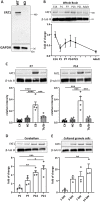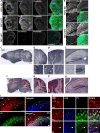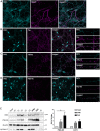Postnatal expression profiles of atypical cadherin FAT1 suggest its role in autism
- PMID: 34100899
- PMCID: PMC8214424
- DOI: 10.1242/bio.056457
Postnatal expression profiles of atypical cadherin FAT1 suggest its role in autism
Abstract
Genetic studies have linked FAT1 (FAT atypical cadherin 1) with autism spectrum disorder (ASD); however, the role that FAT1 plays in ASD remains unknown. In mice, the function of Fat1 has been primarily implicated in embryonic nervous system development with less known about its role in postnatal development. We show for the first time that FAT1 protein is expressed in mouse postnatal brains and is enriched in the cerebellum, where it localizes to granule neurons and Golgi cells in the granule layer, as well as inhibitory neurons in the molecular layer. Furthermore, subcellular characterization revealed FAT1 localization in neurites and soma of granule neurons, as well as being present in the synaptic plasma membrane and postsynaptic densities. Interestingly, FAT1 expression was decreased in induced pluripotent stem cell (iPSC)-derived neural precursor cells (NPCs) from individuals with ASD. These findings suggest a novel role for FAT1 in postnatal development and may be particularly important for cerebellum function. As the cerebellum is one of the vulnerable brain regions in ASD, our study warrants further investigation of FAT1 in the disease etiology.
Keywords: Autism; Cadherin; Cerebellum; FAT1; Granule cells; Neural precursor cells.
© 2021. Published by The Company of Biologists Ltd.
Conflict of interest statement
Competing interests The authors declare no competing or financial interests.
Figures




Similar articles
-
Regulation of Neural Circuit Development by Cadherin-11 Provides Implications for Autism.eNeuro. 2021 Jul 7;8(4):ENEURO.0066-21.2021. doi: 10.1523/ENEURO.0066-21.2021. Print 2021 Jul-Aug. eNeuro. 2021. PMID: 34135003 Free PMC article.
-
Conditional deletion of Cadherin 13 perturbs Golgi cells and disrupts social and cognitive behaviors.Genes Brain Behav. 2018 Jul;17(6):e12466. doi: 10.1111/gbb.12466. Epub 2018 Mar 15. Genes Brain Behav. 2018. PMID: 29446202 Free PMC article.
-
FAT1 cadherin controls neuritogenesis during NTera2 cell differentiation.Biochem Biophys Res Commun. 2019 Jun 30;514(3):625-631. doi: 10.1016/j.bbrc.2019.04.197. Epub 2019 May 7. Biochem Biophys Res Commun. 2019. PMID: 31076104
-
Developmentally regulated Ca2+-dependent activator protein for secretion 2 (CAPS2) is involved in BDNF secretion and is associated with autism susceptibility.Cerebellum. 2009 Sep;8(3):312-22. doi: 10.1007/s12311-009-0097-5. Epub 2009 Feb 24. Cerebellum. 2009. PMID: 19238500 Review.
-
Exploring the mechanisms underlying excitation/inhibition imbalance in human iPSC-derived models of ASD.Mol Autism. 2020 May 11;11(1):32. doi: 10.1186/s13229-020-00339-0. Mol Autism. 2020. PMID: 32393347 Free PMC article. Review.
Cited by
-
MDVarP: modifier ~ disease-causing variant pairs predictor.BioData Min. 2024 Oct 8;17(1):39. doi: 10.1186/s13040-024-00392-y. BioData Min. 2024. PMID: 39379981 Free PMC article.
-
Whole Genome Sequencing Revealed Inherited Rare Oligogenic Variants Contributing to Schizophrenia and Major Depressive Disorder in Two Families.Int J Mol Sci. 2023 Jul 21;24(14):11777. doi: 10.3390/ijms241411777. Int J Mol Sci. 2023. PMID: 37511534 Free PMC article.
-
Differential regulation of gene expression pathways with dexamethasone and ACTH after early life seizures.Neurobiol Dis. 2022 Nov;174:105873. doi: 10.1016/j.nbd.2022.105873. Epub 2022 Sep 21. Neurobiol Dis. 2022. PMID: 36152945 Free PMC article.
References
-
- Abou Jamra, R., Becker, T., Georgi, A., Feulner, T., Schumacher, J., Stromaier, J., Schirmbeck, F., Schulze, T. G., Propping, P., Rietschel, M.et al. (2008). Genetic variation of the FAT gene at 4q35 is associated with bipolar affective disorder. Mol. Psychiatry 13, 277-284. 10.1038/sj.mp.4002111 - DOI - PubMed
-
- American Psychiatric Association (2013). Diagnostic and Statistical Manual of Mental Disorders, 5th edn. Arlington, VA: American Psychiatric Publishing.
-
- Badouel, C., Zander, M. A., Liscio, N., Bagherie-Lachidan, M., Sopko, R., Coyaud, E., Raught, B., Miller, F. D. and McNeill, H. (2015). Fat1 interacts with Fat4 to regulate neural tube closure, neural progenitor proliferation and apical constriction during mouse brain development. Development 142, 2781-2791. 10.1242/dev.123539 - DOI - PMC - PubMed
Publication types
MeSH terms
Substances
LinkOut - more resources
Full Text Sources
Molecular Biology Databases
Research Materials

